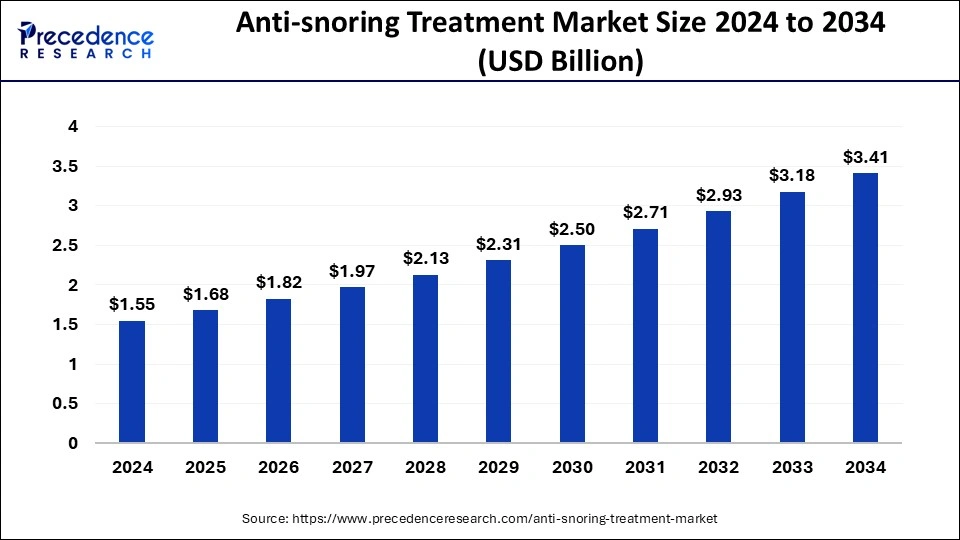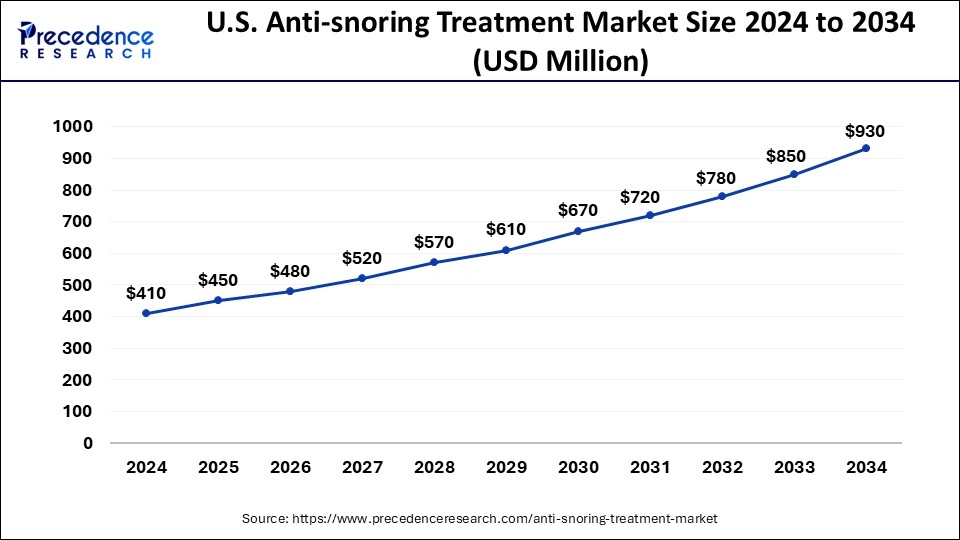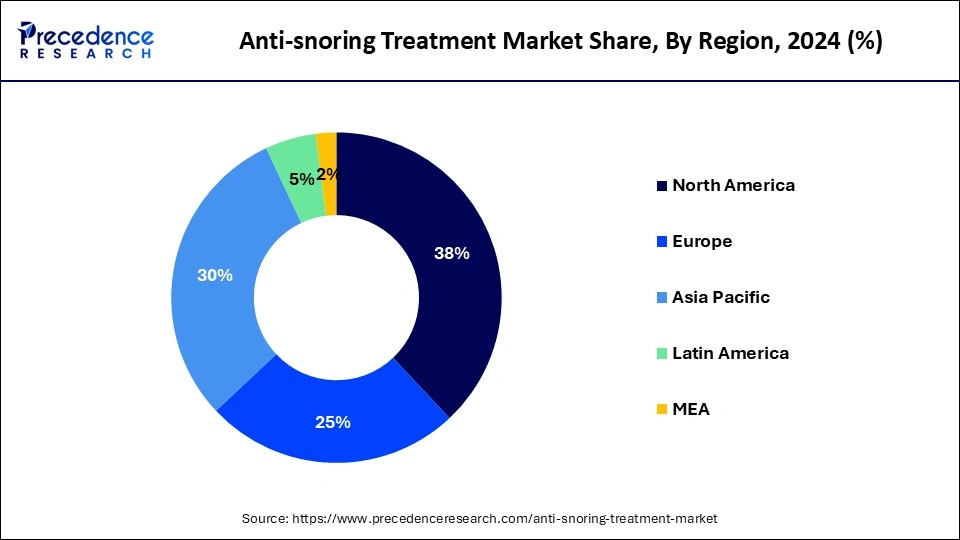List of Contents
Anti-snoring Treatment Market Size and Forecast 2025 to 2034
The global anti-snoring treatment market size was calculated at USD 1.55 billion in 2024 and is predicted to increase from USD 1.68 billion in 2025 to approximately USD 3.41 billion by 2034, expanding at a CAGR of 8.20% from 2025 to 2034.

Anti-snoring Treatment Market Key Takeaways
- The global anti-snoring treatment market valued at USD 1.55 billion in 2024.
- It is projected to reach USD 3.41 billion by 2034.
- The anti-snoring treatment market is expected to grow at a CAGR of 8.20% from 2025 to 2034.
- North America led the global market with the highest market share of 38% in 2024.
- By device type, the continuous positive airway pressure devices segment held the largest share in 2024.
- By distribution channel, the E-commerce segment captured the largest share in 2024.
U.S. Anti-snoring Treatment Market Size and Growth 2025 to 2034
The U.S. anti-snoring treatment market size was exhibited at USD 410 million in 2024 and is projected to be worth around USD 930 million by 2034, growing at a CAGR of 8.54% from 2025 to 2034.

North America led the market with the biggest market share of 38% in 2024, primarily propelled by factors such as the high prevalence of obstructive sleep apnea (OSA) and a well-established network of qualified healthcare professionals specializing in snoring and sleep apnea management. Particularly in the United States, the American Academy of Dental Sleep Medicine (AADSM) plays a crucial role in advancing the field of oral appliance therapy for snoring and sleep apnea. Dentists certified by the AADSM undergo specialized training to deliver effective snoring and sleep apnea solutions through oral appliance therapy, ensuring adherence to rigorous standards and achieving high-quality care and treatment outcomes.

With nearly 30 million adults in the U.S. affected by obstructive sleep apnea, there is a significant demand for comprehensive treatment options. While Continuous Positive Airway Pressure (CPAP) therapy remains prevalent, oral appliance therapy has emerged as a favored alternative, offering comfort and convenience to patients who may not tolerate CPAP well. Moreover, in the region's anti-snoring treatment market, other therapeutic options like positional therapy and upper airway stimulation contribute to the diverse range of solutions available to patients in North America, catering to individual needs and preferences and further bolstering the anti-snoring market in the region.
- In February 2024, an anti-snoring device developed by a couple from Shelburne is aimed at preserving relationships.
Asia Pacific is expected to witness the fastest growth over the forecast. Due to various factors like increased prevalence of obesity, trauma large geriatric population base, and rising awareness about sleeping disorders. India has the largest aging population, witnessing a high rate of problems related to snoring. The prevalence of obesity rates has increased in a region, particularly among the older population, driving trained in expanding demand for anti-snoring treatments. People are becoming aware of sleep disorders and increasing spending on healthcare. Countries like China and India are fueling the market growth.
China is the major player in the Asian market, growth driven by rising obesity rates and associated health issues like sleep apnea. The increased awareness and availability of disposable income are allowing the adoption of anti-snoring treatments in China.
Europe is anticipated to witness notable growth in the market due to the region's increased sleep apnea awareness and the use of smart, data-driven solutions. Well-established healthcare infrastructure and advanced medical technology provide easier access to advanced and effective treatments. Europe is always forefront in adopting novel and innovative technologies. Key market players like Natus Medical, ResMed, and Koninklijke Philips N.V. are shaping market growth.
Market Overview
Snoring in adults poses a common challenge, causing distress for both sufferers and their partners. Effective management necessitates a thorough approach encompassing counseling, diagnostic evaluation, and tailored treatment. While evidence-based recommendations exist for certain scenarios, the overall state of evidence for many diagnostic and therapeutic techniques still needs to be improved. Diagnosis typically involves patient history and clinical examination, with polysomnography serving as the gold standard, supplemented by cardiorespiratory polygraphy when warranted.
Conservative measures such as positional therapy and weight reduction are recommended, although the efficacy of myofascial therapies remains uncertain. Mandibular advancement devices offer a potential instrument-based treatment option for suitable cases. Surgical intervention may be necessary in the presence of concomitant nasal breathing impairment or suspected soft palate abnormalities, with procedures tailored to individual anatomical suitability. It's important to emphasize that snoring, as per this guideline, is not considered a disease, and treatment is pursued only at the patient's discretion, underscoring the significance of a patient-centered approach in decision-making.
- In January 2024, DeRucci introduced its new line of sleep health technologies, which includes smart sleep products such as a smart mattress, an intelligent height-adjustable pillow, AI sleep monitoring, intelligent voice control panels, and curtain tracks.
Anti-snoring Treatment Market Growth Factors
The introduction of 3D digital scanning technology allows for the precise design and fabrication of oral appliances tailored to each individual's unique oral anatomy. These personalized appliances effectively reduce snoring and alleviate obstructive sleep apnea, significantly enhancing sleep quality. This innovation drives the growth of the anti-snoring treatment market by meeting the increasing demand for customized solutions in sleep disorder treatment.
The anti-snoring treatment market experiences growth as healthcare providers increasingly rely on specialized sleep studies and evidence-based recommendations for diagnosing and treating snoring. With a focus on conservative treatments like positioning therapy and weight loss, there's a growing emphasis on comprehensive care, attracting more patients seeking effective solutions and driving market expansion.
As awareness of MAS therapy grows and its efficacy becomes more widely recognized, there is considerable potential for the anti-snoring treatment market expansion and increased adoption among individuals seeking alternative treatments for snoring and sleep apnea.
A novel approach to preventing snoring through posture adjustment during sleep shows promising results. By widening the oropharynx space through cervical spine expansion and dedicated pillows with adjustable angles, this method offers a non-invasive yet effective solution. Such innovative products cater to consumer preferences for comfortable and user-friendly interventions, stimulating market growth.
Anti-snoring beds emerge as a valuable alternative to traditional positional therapy, providing varying angles to optimize airway alignment during sleep. Studies indicate higher success rates in snoring cessation with larger angle interventions, driving demand for these specialized beds and contributing to the expansion of the anti-snoring treatment market.
Market Scope
| Report Coverage | Details |
| Growth Rate from 2025 to 2034 | CAGR of 8.20% |
| Market Size in 2025 | USD 1.68 Billion |
| Market Size by 2034 | USD 3.41 Billion |
| Base Year | 2024 |
| Forecast Period | 2025 to 2034 |
| Segments Covered | Device and Distribution Channel |
| Regions Covered | North America, Europe, Asia-Pacific, Latin America, and Middle East & Africa |
Market Dynamics
Drivers
Rising awareness
As awareness of the health risks associated with sleep apnea grows, demand for effective treatment solutions escalates. Surgical interventions and dental devices emerge as key treatment approaches, targeting anatomical causes of snoring to improve airflow in the airway during sleep. This heightened focus on treatment options propels the expansion of the anti-snoring treatment market, presenting opportunities for growth and innovation in the healthcare industry.
- The National Healthy Sleep Awareness Project highlights snoring as a crucial indicator of obstructive sleep apnea, a prevalent chronic condition affecting approximately 30 million adults in the U.S.
Addressing the global rise in sleep disorders
Despite the widespread impact of sleep disorders worldwide, there is a significant gap in recognition and treatment within clinical practice. This underlines the urgent need for accessible and effective solutions to address sleep-related issues. As awareness grows regarding the crucial role of quality sleep in overall health, there's a rising demand for interventions, driving the expansion of the anti-snoring treatment market. This presents a lucrative opportunity for healthcare providers and innovators to meet the unmet needs of diverse populations and drive meaningful growth in the industry.
- The prevalence of chronic insomnia in the United States alone ranges from 9% to 19%, with higher rates reported among women, minorities, and the elderly, reaching approximately 50%.
Restraints
Challenges and constraints in surgical management of snoring and sleep apnea
The effectiveness and safety of surgical interventions for snoring and sleep apnea, notably laser-assisted uvulopalatoplasty and radiofrequency ablation are hindered by limited evidence stemming from small-scale randomized controlled trials. These studies fail to demonstrate significant improvements in key outcomes such as daytime sleepiness, quality of life, apnea reduction, or snoring.
Procedures like uvulopalatopharyngoplasty pose a notable risk of long-term side effects, notably difficulty swallowing, resulting in reduced optimism for the anti-snoring treatment market. Given these constraints, there is a critical need for further research, particularly randomized controlled trials, to explore alternative surgical approaches with a focus on efficacy and safety beyond conventional methods, aiming to enhance treatment options and patient care in this domain.
Side effects
The prevalence of side effects, such as short-term facial muscle problems and dental issues, presents a challenge to the widespread adoption of anti-snoring treatments, particularly mandibular advancement devices (MAS). While these side effects are often minor, they can impact patient comfort and satisfaction. Balancing the efficacy of MAS in treating snoring and obstructive sleep apnea (OSA) against these potential drawbacks is crucial. However, the existence of side effects may deter some individuals from seeking or adhering to treatment, thereby limiting the growth potential of the anti-snoring treatment market.
Opportunities
Mandibular advancement splints
Mandibular advancement splint (MAS) therapy emerges as a leading alternative to continuous positive airway pressure (CPAP) for obstructive sleep apnea treatment. Functioning akin to a mouth guard, when properly fitted, MAS effectively reduces snoring by advancing the mandible relative to the maxilla, thus widening the airway and minimizing collapsibility. This innovative oral appliance offers a promising opportunity within the anti-snoring treatment market, providing patients with a comfortable and effective solution to address sleep-related breathing disorders.
Advancing personalized treatment
In the anti-snoring treatment market, the evolution towards personalized medicine in obstructive sleep apnea (OSA) treatment underscores the need to acknowledge individual variability among patients. Recent progress in addressing the heterogeneity of OSA signals a promising shift towards precision sleep medicine. However, the reliance on continuous positive airway pressure (CPAP) therapy, coupled with challenges related to patient tolerance, necessitates the exploration of alternative treatment options.
With limited personalization in OSA therapy currently practiced in clinical settings, there exists a significant opportunity for innovation within the anti-snoring treatment market. By developing tailored solutions that address individual patient needs and preferences, providers can capitalize on this growing demand for personalized approaches to OSA management, driving market growth and enhancing patient outcomes.
Device Insights
The continuous positive airway pressure devices segment held the largest share in 2024. This segment offers vital solutions for maintaining open breathing airways during sleep through mild air pressure delivery. Widely prescribed for sleep-related breathing disorders like sleep apnea and beneficial for preterm infants with underdeveloped lungs, CPAP therapy provides numerous health advantages, including the prevention or control of high blood pressure, stroke risk reduction, and cognitive function enhancement.
CPAP machines deliver a steady airflow to prevent airway collapse, thereby improving sleep quality, albeit initial usage discomforts like congestion and dry mouth may occur. While CPAP remains the primary therapy, tailored recommendations from sleep specialists may lead to the adoption of alternative Positive Airway Pressure (PAP) devices based on individual circumstances, emphasizing the importance of understanding diverse offerings in the anti-snoring treatment market.
- In June 2022, we saw the launch of a new anti-snoring device (ASD) by Illusion Aligners. This oral device is designed for ease of use, effectiveness, and comfort.
Distribution Channel Insights
The e-commerce segment captured the largest share in the anti-snoring treatment products in 2024, offering a convenient platform for consumers to access a variety of brands such as AddBeauty, Digital Shoppy, Tirthtreads, and Onsafe (Nasal Strips). Digital Shoppy's snoring aids, made of silicone and plastic with embedded magnets to open nasal passages, promise side-effect-free relief. At the same time, Tirthtreads provides nose clips in a protective case for comfortable insertion into nostrils.
Increased online accessibility allows individuals to address snoring concerns conveniently, with many products boasting non-toxic materials and breathability. Moreover, innovations like smartphone application-administered upper airway training offer promising alternatives to traditional remedies, highlighting the evolving anti-snoring treatment market through e-commerce platforms.
Recent Developments
- In December 2022, Mindray announced the launch of its wearable patient monitoring device, the mWear system, designed to track vital signs and ensure efficient patient care and workflow.
- In July 2022, Glidewell launched a new addition to its portfolio of mandibular advancement devices, the Silent Nite Sleep Appliance with Glidewell Hinge. The device is used to treat snoring and obstructive sleep apnea (OSA).
Anti-snoring Treatment Market Companies
- Apnea Sciences Corp.
- SomnoMed Ltd.
- Airway Management, Inc.
- ResMed Inc.
- Fisher & Paykel Healthcare Corp. Ltd.
- Koninklijke Philips NV
- Sleep Well Enjoy Life, Ltd.
- Tomed Dr. Toussaint GmbH
- MEDiTAS Ltd.
Recent Developments
- In January 2025, the Motion Sleep AI Pillow received the CES 2025 Innovation Award Honoree under the Home Appliances category. The Motion Sheelp AI Pillow is an avant-garde sleep tech product. Source: tomsguide.com
- In September 2024, the AppySleep wristband was launched by AppYea. The AppySleep wristband is a wearable device designed to monitor snoring and help reduce it by encouraging side-sleeping through biofeedback. The device pairs with an AI used app for the detection of irregular breathing patterns and customizing snoring treatments. Source: sleepreviewmag.com
- In December 2024, the obesity medication Zepbound (tirzepatide) received Food and Drug Administration (FDA) approval as the first pharmaceutical treatment for moderate-to-severe obstructive sleep apnea (OSA) in adults with obesity. Source:verywellhealth.com
Segments Covered in the Report
By Device
- Mandible Advancement Devices
- Tongue Stabilizing Devices
- Nasal Devices
- Continuous Positive Airway Pressure Devices
- Chin Straps
- Others
By Distribution Channel
- Hospitals
- Clinics
- Retail Pharmacies
- E-commerce
- Others
By Geography
- North America
- Europe
- Asia-Pacific
- Latin America
- Middle East and Africa
For inquiries regarding discounts, bulk purchases, or customization requests, please contact us at sales@precedenceresearch.com
Frequently Asked Questions
Ask For Sample
No cookie-cutter, only authentic analysis – take the 1st step to become a Precedence Research client